An overview of the USPS
"Why the Post Office matters"
"The history of its post office is nothing less than the story of America. Of the nation’s founding institutions, it is the least appreciated or studied, and yet for a very long time it was the U.S. government’s major endeavor. Indeed, it WAS that government in the experience of most citizens. As radical an experiment as America itself, the post was the incubator of our uniquely lively, disputatious culture of innovative ideas and uncensored opinions. With astonishing speed, it established the United States as the world’s information and communications superpower."
So begins the excellent book on the history of the Post Office:"How the Post Office Created America" by Winifred Gallagher (here, here, NPR interviews with Winifred: here and here). It is a fascinating read, very well researched and documented, and should be a standard read for anyone interested in the history of the United States itself.
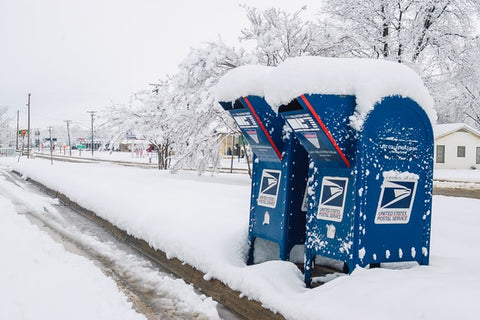
Origins

In fact, the Post Office was established before the Declaration of Independence was even signed! In 1775 Benjamin Franklin was appointed its first Postmaster General. These 'revolutionaries' wanted a good way to talk 'treason' (in the eyes of the British) and established many post roads in order to do so.
When the U.S. Constitution was ratified in 1789 it gave Congress the power to “establish post offices and post roads.” (Constitution Article I, Section 8, Clause 7 (here))
![]()
![]()
Then in 1792, the Postal Service Act was signed by President George Washington, thereby creating the 'Post Office Department'. In 1970 the 'Postal Reorganization Act' transformed the Post Office Department into the United States Postal Service (USPS) we all know and love today.
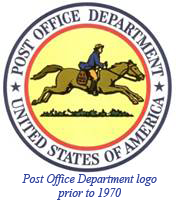
The USPS today
The United States Postal Office is an amazing organization spanning the complete United States, from the depths of the Grand Canyon to the most western Post Office location in Adak, AK.
All of us have a relationship with the USPS and it's part of our daily live. Who doesn't love the sight of their mailman delivering mail, holding the promise of a nice birthday card or that long awaited tax refund?
USPS, the people
In 2019 the USPS employed almost 500.000 people (down from the all time high of almost 800.000 in 1999 (here)). Of those 500.000, 97.000 are military veterans (here). The USPS, over the years, also had some very notable people serve in it's ranks: Bing Crosby, Walt Disney, Rock Hudson, Steve Carell, and even Abraham Lincoln himself got their start working for this amazing organization (here).
And did you know that every USPS employee takes the oath of office, the same one the President of the United States takes (here)?
Mail carriers across the US have organised in powerful unions representing their rights. The biggest unions are:
- American Postal Workers Union (APWU) with 330k members (here and here)
- National Association of Letter Carriers (NALC) with 227k members (here and here)
- National Rural Letter Carriers' Association (nrlca) with 115k members (here and here)
- National Postal Mail Handlers Union (NPMHU) with 50k members (here and here)
USPS, the organization

The United States Postal Service is an independent agency of the executive branch of the United States federal government responsible for providing postal service in the United States. The highest ranking USPS employee is the Postmaster General (PMG). The PMG is not appointed by the President, but by the Board of Governors, who are nominated by the President (here).
From November 2014 till May 2020 the PMG was Megan Brennan. In May 2020 Louis DeJoy took over that role.
Contrary to popular belief, the USPS does NOT rely on tax-payer funding. All expenses are paid for with income generated by offering its products and services.
While the USPS has a monopoly on First Class mail delivery (but not on parcel delivery), that monopoly also comes with a so-called Universal Service Obligation (USO). The USO states that the USPS is required to provide all its services along the full geographic scope, range of products, access to services and facilities, delivery frequency, affordable and uniform pricing, service quality, and security of the mail. Other carriers might offer delivery on a universal basis, but the USPS is the only carrier obligated to provide ALL aspects of universal service at the same affordable prices.
Due to growth in the American population, and thereby the number of delivery points, this has led to a significant increase in the USPS’ fixed costs, while over the last few years mail volumes, especially First Class mail volumes, have taken a very noticeable downward turn. While the USPS may have a limited statutory monopoly on First Class mail, the reality is that there are alternatives to every piece of mail from more cost effective competitors.
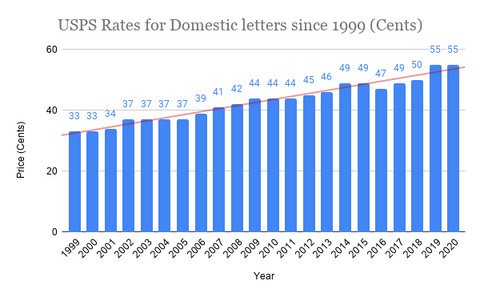
The price of a First Class stamp for instance is 55 cents (2020) and contributes to a large portion of it's income, however the USPS has limited control over the price of a First Class stamp (so much for the independent part of the US Government). The price is in fact set by the Postal Regulatory Commission ('PRC', previously 'Postal Rate Commission' (here). The PRC is a political body and proposed price increases have to be voted on, making it difficult to raise the price to what they should be, to make economical sense.

As a last, the USPS is consistently rated high and valued by a large majority of the US population. In fact it is THE most favorable US organization by over 90% of the population (2019, 2020). Certainly during the Covid-19 epidemic of 2020 the USPS was seen as as one of the essential companies (here).
USPS, the challenges
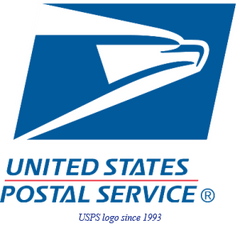
Sadly, not all is well with the USPS. Sure, its nice to have a monopoly on the delivery of First Class mail, but if that volume is dwindling, it's of little use. Combine that with the USO which requires the USPS to deliver all of it's services no matter where someone lives. A 3 miles dirt road to get to a last address in a remote rural location? The USPS has to deliver at the same rates as in densely populated urban areas.
To add a bit of insult to injury, in 2006 Congress established a 'prefunding mandate' in the 'Postal Accountability and Enhancement Act'. This act stated that the USPS had to prefund all their employees health and pension liabilities. While this is absolutely wonderful for USPS employees, who can sleep well knowing that the money will be there when they need it, it's not something other government entities are required to do, let alone something you'd see in the private sector.
Due to this act, the USPS has lost money for 13 consecutive years (with a majority of those losses as a result from this prefunding requirement). In February of 2020 Congress voted to overturn this requirement though, but the USPS is not out of the woods yet.
With limited control over postal rates (set by the PRC), a decline in First Class mail volumes and an USO requiring universal services at universal prices, it's indeed very hard for the USPS to be financially successful.
Add to that the constant calls (mostly from Republican politicians) for the privatization of the USPS. 'Because the USPS does so badly, we're better of privatizing it!' is an often heard criticism. But in all fairness, that's totally not fair.
Privatizing the USPS would invariable lead to different cost structures and rural America will pay the price for it (here, here). Others have argued instead to massively expand the USPS, and let it offer additional services like postal banking (here).
The USPS' five-year plan (2020-2024) can be found (here).
In March 2021, the USPS published a new 10 year plan and can be found (here).
USPS, fun facts!
A compilation of fun facts (here, here, here, OK, one more here)
- The USPS operates one of the largest civilian vehicle fleets in the world, with an estimated 227,896 vehicles called 'LLV's' or long-life vehicle.
- You used to be able to mail babies via the USPS (here).
- There is a 'subreddit' on Reddit where people offer to send cards to strangers (here).
- The USPS maintains a postal-bulletin with interesting tidbits (here).
- The Hope Diamond was mailed to the Smithsonian Museum via the USPS (here).
- The longest United States Postal Service mail route is more than 190 miles long.
- The USPS maintains a 'Stamp Cave' in Subtropolis, a limestone cave (here).
- During the Covid Pandemic a Change.org petition was filed to keep workers safe by providing only essential mail.
- The mailbox is a truly interesting device (here)
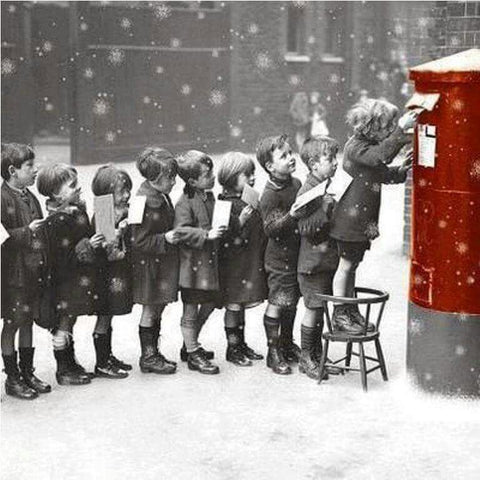
USPS, Systems at work
This 9:30 minute overview video is well worth the watch!
